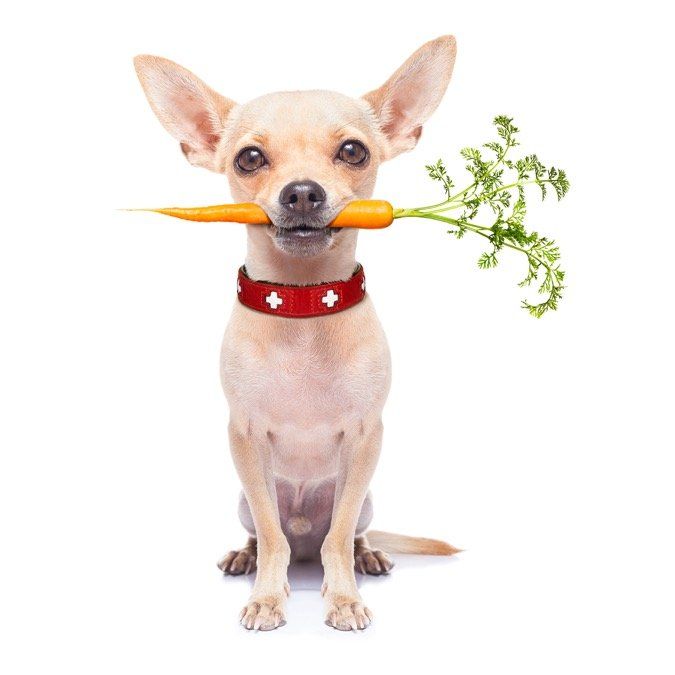Since we’re in the middle of fall, let’s start this discussion about fiber with pumpkins. Dog owners, as well as veterinarians, often add pumpkin to pets’ diets to increase the food’s fiber content, according to the head of the Clinical Nutrition Service at the Tufts Cummings School, Lisa Freeman, DVM, PhD, DACVN. She hears it all the time, she writes on Tufts’s Petfoodology site (vetnutrition.tufts.edu/petfoodology). Most commonly, they report to her that they add anywhere from a quarter teaspoon to two tablespoons of pumpkin to their dog’s chow. What does that amount of fiber do?
Probably not much, if anything. To put the amount typically added to a dog’s diet into context, to reach the level of fiber found in one popular high-fiber diet for dogs that can be had by prescription from a veterinarian, you’d need to feed a medium-size dog (20 to 50 pounds) nearly 12 cups of pumpkin a day. Should people be doing that?
The surprising truth about dogs’ fiber requirement
Strictly speaking, dogs do not require any fiber in their diets. People are advised to consume in the neighborhood of 25 to 35 grams of fiber a day, which means eating plenty of vegetables, whole grains, and fruits. But it’s not because fiber contains any nutrients to speak of. It doesn’t. It’s not even readily digestible, meaning it passes through the stomach, small intestine, and colon pretty much without being broken down; thus, whatever nutrients or other substances it does contain are not able to be absorbed by the bloodstream and taken up for use in the body. Rather, depending on its composition, fiber can be useful as nature’s broom, so to speak, helping to insure the timely passage of food through the body and voiding of waste without diarrhea at one extreme and constipation at the other. It is also believed to help regulate appetite for people working to manage their weight by virtue of the bulk it provides, and it is recommended for those with diabetes because its presence slows the uptake of sugar by the body and therefore keeps blood glucose levels on a more even keel.
Interestingly, while fiber is not considered essential for dogs — there is no recognized optimal amount — it serves the same purposes for them as for us: helping to avoid diarrhea and constipation, modulating blood sugar levels, perhaps helping an overweight pet feel more full, even keeping down too-high levels of fat in the blood. All labels of commercially prepared dog food give at least some information about the amount of fiber inside the package. Unfortunately, it’s not readily decipherable.
Trying to decode food labels for fiber content
© Javier Brosch | Bigstock


Fiber is listed on food for people as “dietary fiber,” giving the number of grams of fiber per serving so it’s easy to count up over the course of a day. Check out any cereal box or package of frozen or canned vegetable or fruit, or any package of whole-wheat bread or other whole-grain foods.
It’s less straightforward on a bag or can of dog food. Fiber content is listed in a table called “Guaranteed Analysis,” and it’s listed as a maximum percentage rather than an absolute amount, making gram tallying pretty impossible. (It always looks like dry food has a higher percentage of fiber than canned because of all the water in canned food. But serving for serving, the fiber content of dry kibble and canned food are not necessarily so different.)
What dog food labels (and many people food labels) also don’t list are the types of fiber in the product. There are essentially two kinds: soluble and insoluble, and they have different effects on the body. Insoluble fiber is the kind most commonly associated with insuring timely passage of food through the GI tract — not too slow, which leads to constipation. It also “dilutes” calories for people or dogs on weight-loss plans.
Many types of soluble fiber, while indigestible for us and our dogs, actually provide food for our healthy gut bacteria. The gut bacteria in turn produce special fats that then provide nutrients to our gut cells. Thus, while we can’t get nutrients directly from the fiber itself, with the help of our gut bacteria, fiber can definitely have nutrition benefits. Soluble fiber can also help control blood sugar and blood levels of fats. And it has properties to help avoid diarrhea (by “gelling” excess water in the stool) as well as constipation (by keeping the stool softer).
But dog food labels report only “crude fiber” — which is basically the insoluble kind. So what do you do? How do you choose?
Don’t go it alone
The amount and type of fiber in different brands of dog food can vary dramatically from one to another. Diets marketed as lower-calorie or for weight control are more likely to be relatively high in fiber, but even these diets vary quite a bit. Some dogs are very tolerant of different types and amounts of fiber, while for others it may take some trial and error to find a diet that produces the ideal stool quality.
If your dog tends to have diarrhea or suffer from constipation, or has diabetes or high blood fats (unusual for dogs, although it does happen), you might be tempted to add various fruits and vegetables or fiber supplements to your pet’s meals. Don’t. At least not without consulting a board-certified veterinary nutritionist (which you can find at www.acvn.org). Dr. Freeman explains that a veterinarian with board certification in nutrition can prescribe a therapeutic diet that contains increased amounts of specific types of fiber — soluble, insoluble, or a mixture of the two, depending on your pet’s individual needs. Alternatively, fiber supplements can be added to your dog’s food in the form of purified cellulose or wheat bran (for insoluble fiber), various over-the-counter human fiber supplements such as inulin (for soluble fiber), or supplements that contain a mixture of both (such as psyllium). Keep in mind that adding fiber to an existing diet can alter absorption of nutrients in the diet, which is part of the reason having expert advice is valuable.
Of course, a veterinarian board-certified in nutrition will also be able to tell you whether fiber is likely to be the solution for what ails a dog. Sometimes it can look like fiber is the solution to a problem when it may not be; a dog may have an underlying disease that’s causing GI problems or other difficulties. Once the disease is dealt with, the issue goes away.






Adding fiber to my chihuahua’s diet has been critical to keeping her anal gland function normal. She had soft and runny stools her entire life and always did the scooting motion on the carpets, until finally developing a painful anal gland abscess that required treatment. Since that healed, I have been regularly supplementing her diet with fiber as the firmer stools help to squeeze on the anal gland and keep it clean and cleared out normally. My dog has been healthy without scooting or anal gland issues ever since, and the watery stool problem is finally gone.
Hi! Wondering how much fiber you added to her diet?
This is ridiculous, how can a veterinarian prescribe a food is the label is not saying what kind of fiber is in it???? Bad from the start. Go natural. That’s the only way to jnow what you are feeding your dog and most commonly the vetriarian doesn’t, because they are trained to tell you what dry food companies tell them: nothing. Hence nutrition is a business and not a compromise.
One of our little dogs gets plenty of fiber from chewing the fuzz off tennis balls (I’m kidding – mostly). The interesting thing about pumpkin and other sources of fiber is that it can be beneficial when a dog has constipation or diarrhea – sounds counterintuitive. But really it all comes down to having a balanced diet just the same as it is for us humans.
I added a fiber probiotic blend to my dogs’ night feeding. Both dogs have benefited GREATLY.
My Blue Nose Pit had severely itchy skin and nothing worked. Not even limited diet. Now I added the fiber blend and she is itching far less. Had taken 2 mths tho.
My husky shepherd shed like a tumble weed. Within 2mths my home is fur free. She too had glandular issues, scooting and soft stools and now is healthy and i normal